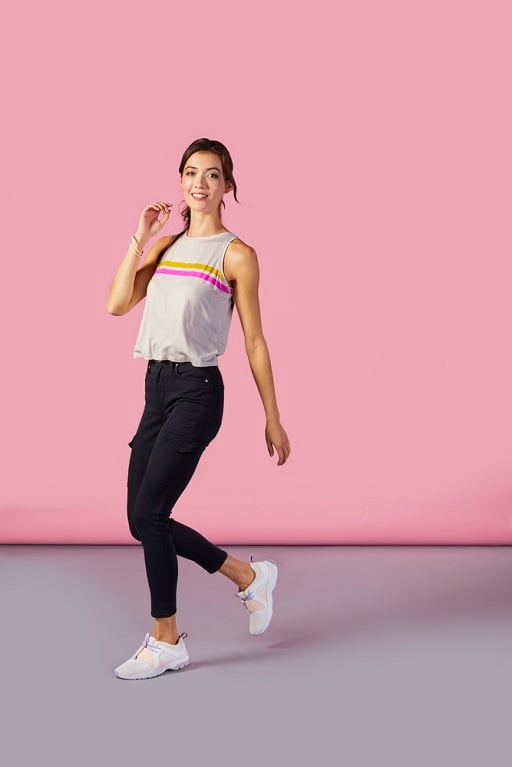 Boasting a sporty vibe, year-round versatility, and an endlessly comfortable feel, active footwear has a place in virtually everyone’s wardrobe. If you’re in the market for a new pair of kicks, you might be wondering about the difference between sneakers and tennis shoes especially if you’re trying to find comfortable shoes.
Boasting a sporty vibe, year-round versatility, and an endlessly comfortable feel, active footwear has a place in virtually everyone’s wardrobe. If you’re in the market for a new pair of kicks, you might be wondering about the difference between sneakers and tennis shoes especially if you’re trying to find comfortable shoes.
Is there a distinction between the two, and if so, how are they different? The footwear aficionados at Vionic are here to clear the air and settle the tennis shoes vs. sneakers debate once and for all. Let’s get started.
Getting down to basics: Tennis Shoes
What are tennis shoes? Tennis shoes are essentially lace-up shoes with textile uppers and rubber soles. They’re called tennis shoes because they were initially designed for folks who played—you guessed it—tennis.¹ But before that, canvas shoes with rubber outsoles were called plimsolls, a footwear style worn by 19th-century vacationers.²
Throughout the late 1800s and into the early 20th century, tennis became a more popular pastime. At that point, the footwear style was further developed with better flexibility, stability, and cushioning to keep players comfortable on the court.
Over the decades, tennis shoes evolved into a footwear style no longer worn exclusively by tennis players. Today’s iterations of the active shoes are a mainstay for everything from biking, croquet, and walking to aerobics, running, and basketball.

What Are Sneakers?
Sneakers are traditionally active shoes that evolved into a category including both athletic and casual styles. Like tennis shoes, they usually have rubber soles and textile uppers. However, many modern sneakers styles feature various upper materials, such as leather, suede, mesh, and neoprene.
Thanks to the flexible rubberized outsoles, sneakers make almost no sound on hard court surfaces. They were historically called sneakers because, unlike dress shoes and high heels, you could sneak around quietly while wearing them.
The first running shoes and basketball shoes came to market around the turn of the 20th century, though they wouldn’t have their moment for another 50 years or so. After World War II, when school dress codes started to relax and leisure activities expanded, kids and teens began wearing sneakers not just for playing but for casual wear.³
History of Tennis Shoes vs. Sneakers
Humans have been wearing shoes for several centuries, but the first active styles appeared much later. Here’s a general timeline of tennis shoes and sneakers throughout history.
- Mid-1800s: The first canvas footwear with rubber outsoles (aka plimsolls) is created and worn primarily by vacationers and the leisure class.³
- Late 1800s: Newer versions of plimsolls are developed with thicker rubber soles and engraved treads to accommodate tennis players.³ Badminton shoes and croquet shoes are also developed.
- 1890s: The world’s first running shoe comes to market.³
- Early 20th Century: Olympic track teams throughout Europe order running shoes to compete in the Summer Games.³
- 1920s: The world’s first basketball shoe is created.
- Post-World War II: The American sneaker market continues to grow, and active-style shoes become popular among children and teens for casual wear.⁵
- 1970s–1980s: As jogging and aerobics become more popular adult pastimes, the demand for tennis shoes spikes.⁵
- 1990s–Early 2000s: Active footwear is at the forefront of mainstream fashion, and donning the newest styles becomes the ultimate form of self-expression. Top brands are being endorsed by professional athletes.⁵
The sneaker industry saw exponential growth in recent decades. In 1970, there were only five tennis shoe models on the market, then 285 in 1998, and a whopping 3,371 in 2012.⁶
Modern tennis shoes and sneakers include a wide range of styles. From cross-trainers, running shoes, and walking shoes to fashion sneakers, slip-on sneakers, and high-tops, there’s something for everyone and every activity. There are also plenty of outfits with tennis shoes that you can play with.
Tennis Shoes vs. Sneakers: Is There Actually a Difference?
Tennis shoes and sneakers have slightly different histories, and some may argue that they bear distinct differences. In the modern world, however, the terms are generally synonymous.
Nowadays, tennis shoes and sneakers are used to describe virtually any type of athletic or active-inspired footwear, save for active sandals. In fact, the word you use probably has more to do with where you live than the actual design or purpose of the shoe.
Aside from those living in a few eastern states, most people in the U.S. use the term tennis shoes when talking about athletic footwear. Europeans, on the other hand, are more likely to call them trainers or simply sports shoes.⁴
So, is there an actual difference between sneakers and tennis shoes? Historically, yes. Technically speaking, maybe. But for all intents and purposes, they’re one and the same.
Street Shoes vs. Active Shoes
Some people say sneakers are more of a casual footwear category, while tennis shoes are primarily active. This notion mostly draws on the fact that, back in the day, tennis shoes were engineered specifically to provide support on clay courts.
While clay-court clay court tennis shoes are still a thing, they’re generally intended for professional athletes and serious tennis players. When folks talk about tennis shoes and sneakers today, they’re usually referring to all types of active footwear.
At Vionic, we carry a wide range of active and casual sneaker styles for men and women. While all designs feature durable rubber outsoles and our exclusive Vio-Motion Support orthotics, our athletic shoes are generally lightweight with breathable uppers and cushioned heels.
Vionic’s casual sneakers, on the other hand, are more fashion-forward. Designed for everyday wear, they feature leather, suede, embossed, animal-hide, or stretchy canvas uppers and come in a range of colors and prints.

Where to Buy the Best Tennis Shoes and Sneakers
Whether you call them sneakers, trainers, gym shoes, training shoes, tennis shoes, or tennies, you’ll always be glad to have a good pair of active shoes at the ready. Now that you’re up to speed on the difference (or lack thereof) between tennis shoes and sneakers, you can move forward with buying a fresh pair of kicks.
When shopping around, you’ll want to look for styles with:
- Breathable uppers
- Durable rubber outsoles
- Patterned tread
- Laces, bungees, or elastic gore panels
- Arch support
- Cushioning
- Shock absorption
- Deep heel cups
- Whole-foot stability
If you think this sounds like a tall order, we’re happy to tell you the styles from Vionic check all the boxes. Each pair of lightweight shoes is biomechanically engineered to hug your arches and keep your feet stable while promoting a natural stride.
Shop men’s and women’s casual sneakers, women’s active shoes, and walking shoes men’s tennis shoes with arch support from Vionic today!
From men’s tennis shoes with arch support to women’s active footwear, shop performance footwear from Vionic today!
External Sources:
- “Tennis shoes”. Encyclopedia. https://www.encyclopedia.com/sports-and-everyday-life/fashion-and-clothing/clothing-jewelry-and-personal-adornment/tennis-shoes
- “Plimsoll”. Cambridge Dictionary. https://dictionary.cambridge.org/us/dictionary/english/plimsoll
- “The History of the Sneaker”. The Washington Post. https://www.washingtonpost.com/archive/lifestyle/2002/05/14/the-history-of-the-sneaker/aa2096d1-a7e2-4427-a324-cb603512722d/
- Walt Hickey. “22 Maps That Show How Americans Speak English Totally Differently From One Another”. Business Insider. Jun 5, 2013. http://www.businessinsider.com/22-maps-that-show-the-deepest-linguistic-conflicts-in-america-2013-6?op=1
- Stephen M. Pribut and Douglas H. Richie. “2002: A Sneaker Odyssey”. Dr. Stephen M. Pribut’s Sport Pages. https://www.drpribut.com/sports/sneaker_odyssey.html
- Aichner, T., Coletti, P. Customers’ online shopping preferences in mass customization. J Direct Data Digit Mark Pract 15, 20–35 (2013). https://doi.org/10.1057/dddmp.2013.34
- Kent van Alstyne. “Difference Between Tennis and Running Sneakers”. Live Strong. Jul 12, 2019. https://www.livestrong.com/article/502869-difference-between-tennis-and-running-sneakers/
- Charles Pettman. “Africanderisms”. Google books. https://books.google.com/books?id=0TYZswEACAAJ
- Tim Newcomb. “The evolution of tennis shoes: From plimsolls to Stan Smiths and Nikes”. SI. Nov 18, 2015.https://www.si.com/tennis/2015/11/18/tennis-shoes-stan-smith-john-mcenroe-pete-sampras


Leave a Reply